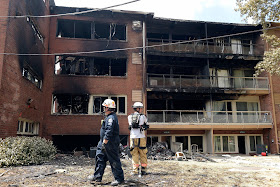Case presentation
A
44-year-old Caucasian man was working under a car when the vehicle’s
transmission system fell on his chest, squeezing his torso between the
heavy item and the ground. After an unknown time, he was found in an
unconscious state by a relative, who called for medical aid. It was
estimated that at least one hour elapsed before our patient received
medical care.
On arrival to our emergency department,
our patient had a gasping breath without foreign bodies in his oronasal
cavities, palpable regular pulses with a rate of 130 beats per minute
and an arterial pressure of 80/40mmHg. On pulse oxymetry he had a
saturation of 80% on room air. His Glasgow Coma Scale score was 8
(absent eye opening, unintelligible voice responses and limp withdrawal
to painful stimuli), his papillae were isochoric and light reflexes were
bilaterally present. Because of his altered consciousness and impending
respiratory failure, our patient was urgently intubated and put under
controlled mechanical ventilation.
The rest of the
physical examination revealed that his face, the front part of his neck
and the upper part of his chest were congested, edematous and covered
with numerous petechiae, especially on the conjunctivae and the
periorbital skin. In a later bedside ophthalmologic examination, mild
bilateral periorbital swelling, severe bilateral subconjunctival
hemorrhages, chemosis, mild exophthalmos and mild optic disc edema were
observed. Ecchymotic bruises were also noted on the back part of his
neck and the upper part of both shoulders. His tympanic membranes were
clear and there were no mucosal hemorrhages of his upper airways.
Absence
of breathing sounds over both lung apices in combination with palpable
subcutaneous emphysema over his neck pointed towards the existence of
bilateral pneumothorax. Moreover, bloody fluid was drained through the
endotracheal tube, indicating possible lung contusions. The physical
examination of his heart and abdomen was unremarkable and
electrocardiogram was normal. Thoracic X-ray examination revealed
bilateral pneumothorax and multiple rib fractures (Figure ).
In this respect, bilateral tube thoracostomies were inserted, draining
air and blood and eliciting major improvement in his hemodynamic
parameters. In subsequent X-rays, bilateral lung opacities were evident,
which were consistent with the clinical suspicion of lung contusions.
Fiberoptic bronchoscopy was not performed due to the bilateral
pneumothorax. Subsequently, our patient was transferred to our intensive
care unit (ICU). Arterial blood gases on admission to our ICU were: pH
7.246; partial pressure of carbon dioxide: 58.3mmHg; partial pressure of
oxygen: 441mmHg; bicarbonate: 21.9mEq/L; oxygen saturation: 99.9%; and
lactate: 1.1mmol/L while our patient was ventilated with a frequency of
15 breaths/min; tidal volume: 700mL; positive end-expiratory pressure:
5cmH2O; and fraction of inspired oxygen: 100%. His Acute
Physiology and Chronic Health Evaluation II score was 14, while his past
medical history was noted to be non-significant.
Chest X-ray taken after tube thoracostomies were inserted.
Note multiple rib fractures, subcutaneous emphysema, multiple lung
opacities, particularly on the right, corresponding to sites of lung
contusion and residual pneumothorax on the left side.
Further
work-up included radiological evaluation of his spine and limbs, which
was unremarkable, a normal echocardiography, and head, neck, chest and
abdomen computed tomography (CT). On the CT scan, a mild brain edema
without signs of hemorrhage was observed, while CT of his chest revealed
bilateral hemopneumothorax and sizeable bilateral lung contusions,
particularly on his right lung (Figure ).
Computed tomography scan of the chest showing bilateral hemopneumothorax and multiple lung contusions, especially on the right.
Serum
biochemistry included elevated levels (ten times above the upper limits
of normal) of creatine phosphokinase, lactic dehydrogenase, aspartate
aminotransferase and alanine aminotransferase. A urine analysis was
normal (Table ).
Laboratory parameters of the patient during his stay in the intensive care unit
In
the ICU, our patient was ventilated with volume-control mode, with a
tidal volume of 7mL/kg, frequency 10 to 12 per minute, positive
end-expiratory pressure not exceeding 5cmH2O and a gas
mixture that was quickly tapered to a fraction of inspired oxygen of
40%. The unimpeded ventilation, the swift restoration of hypercapnia,
hypoxia and hemodynamics, the spontaneous containment of the
tracheobronchial hemorrhage, the rapid radiographic improvement in the
following days (disappearance of the opacities) and the quick recovery,
simply by placing thoracostomies tubes, made the event of a potential
rupture of major bronchial or arterial branch less plausible. Therefore,
we did not proceed to further invasive diagnostic procedures, such as
bronchoscopy, which would have added no more information towards the
appropriate management of our patient and would even pose some risks.
Fluid
resuscitation with crystalloids was copious, in order to prevent renal
complications of a potential traumatic rhabdomyolysis. Special care for
the brain edema was taken with mannitol administration and frequent
neurologic assessments. Regarding his respiratory function, our patient
improved swiftly, resulting in an uneventful extubation on the second
day of ICU hospitalization. However, his neurologic status lagged
behind, as he remained disoriented and agitated until the fourth day.
Facial and thoracic petechiae gradually faded within the next three
days. Serum aspartate aminotransferase, alanine aminotransferase,
creatine phosphokinase and lactic dehydrogenase levels decreased to
normal on the seventh day and our patient was discharged from the ICU
and transferred to the thoracic surgical ward.
Authors’ information
Eleni
Sertaridou, MD is a Surgeon-Intensivist at the ICU University Hospital
of Alexandroupolis, Alexandroupolis, Greece. Vasilios Papaioannou, MD,
MSc, PhD is an Assistant Professor of Critical Care Medicine at the ICU
University Hospital of Alexandroupolis, Alexandroupolis, Greece.
Georgios Kouliatsis, MD is a Pulmonologist-Intensivist at the ICU
University Hospital of Alexandroupolis, Alexandroupolis, Greece.
Vasiliki Theodorou, MD is an Anaethesiologist-Intensivist at the ICU
University Hospital of Alexandroupolis, Alexandroupolis, Greece. Ioannis
Pneumatikos, MD, PhD, FCCP is a Professor of Critical Care Medicine at
the Democritus University of Thrace and Head of ICU, University Hospital
of Alexandroupolis, Alexandroupolis, Greece.













































